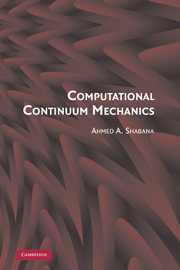4 - Constitutive Equations
Published online by Cambridge University Press: 06 July 2010
Summary
The kinematic and force equations developed in the preceding two chapters are general and applicable to all types of materials. The mechanics of solids and fluids is governed by the same equations, which do not distinguish between different materials. The definitions of the strain and stress tensors, however, are not sufficient for describing the behavior of continuous bodies. The force–displacement relationship or equivalently the stress–strain relationship is required in order to be able to distinguish between different materials and solve the equilibrium equations. The continuum displacements depend on the applied forces, and the force–displacement relationship depends on the material of the continuum. To complete the specification of the mechanical properties of a material, one needs additional set of equations called the constitutive equations, which serve to distinguish one material from another. The form of the constitutive equations of a material should not be altered in the case of a pure rigid-body motion. These equations, therefore, must be objective, and should not lead to change in the work and energy of the stresses under an arbitrary rigid-body motion. Using the constitutive equations, the partial differential equations of equilibrium obtained in the preceding chapter can be expressed in terms of the strains. Using the strain–displacement relationships, these equilibrium equations can be expressed in terms of displacements or position coordinates and their time and spatial derivatives.
- Type
- Chapter
- Information
- Computational Continuum Mechanics , pp. 131 - 176Publisher: Cambridge University PressPrint publication year: 2008
- 1
- Cited by



